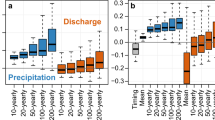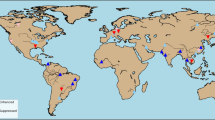Abstract
A warmer climate would increase the risk of floods1. So far, only a few studies2,3 have projected changes in floods on a global scale. None of these studies relied on multiple climate models. A few global studies4,5 have started to estimate the exposure to flooding (population in potential inundation areas) as a proxy of risk, but none of them has estimated it in a warmer future climate. Here we present global flood risk for the end of this century based on the outputs of 11 climate models. A state-of-the-art global river routing model with an inundation scheme6 was employed to compute river discharge and inundation area. An ensemble of projections under a new high-concentration scenario7 demonstrates a large increase in flood frequency in Southeast Asia, Peninsular India, eastern Africa and the northern half of the Andes, with small uncertainty in the direction of change. In certain areas of the world, however, flood frequency is projected to decrease. Another larger ensemble of projections under four new concentration scenarios7 reveals that the global exposure to floods would increase depending on the degree of warming, but interannual variability of the exposure may imply the necessity of adaptation before significant warming.
This is a preview of subscription content, access via your institution
Access options
Subscribe to this journal
Receive 12 print issues and online access
$209.00 per year
only $17.42 per issue
Buy this article
- Purchase on Springer Link
- Instant access to full article PDF
Prices may be subject to local taxes which are calculated during checkout



Similar content being viewed by others
References
IPCC Managing the Risks of Extreme Events and Disasters to Advance Climate Change Adaptation (eds Field, C. B. et al.) (Cambridge Univ. Press, 2012).
Milly, P., Wetherald, R., Dunne, K. & Delworth, T. Increasing risk of great floods in a changing climate. Nature 415, 514–517 (2002).
Hirabayashi, Y., Kanae, S., Emori, S., Oki, T. & Kimoto, M. Global projections of changing risks of floods and droughts in a changing climate. Hydrol. Sci. J. 53, 754–772 (2008).
Jongman, B., Ward, P. J. & Aerts, J. C. J. H. Global exposure to river and coastal flooding: Long term trends and changes. Glob. Environ. Change 22, 823–835 (2012).
Peduzzi, P., Dao, H., Herold, C. & Mouton, F. Assessing global exposure and vulnerability towards natural hazards: The Disaster Risk Index. Nat. Hazards Earth Syst. Sci. 9, 1149–1159 (2009).
Yamazaki, D., Kanae, S., Kim, H. & Oki, T. A physically based description of floodplain inundation dynamics in a global river routing model. Wat. Resour. Res. 47, W04501 (2011).
Van Vuuren, D. et al. The representative concentration pathways: an overview. Climatic Change 109, 5–31 (2011).
Seneviratne, S. et al. in Managing the Risks of Extreme Events and Disasters to Advance Climate Change Adaptation (eds Field, C. B. et al.) 109–230 (Cambridge Univ. Press, 2012).
Meehl, G. et al. The WCRP CMIP3 multimodel dataset: A new era in climate change research. Bull. Am. Meteorol. Soc. 88, 1383–1394 (2007).
Taylor, K., Stouffer, R. & Meehl, G. An overview of CMIP5 and the experiment design. Bull. Am. Meteorol. Soc. 93, 485–498 (2011).
Moss, R. et al. The next generation of scenarios for climate change research and assessment. Nature 463, 747–756 (2010).
Dankers, R. & Feyen, L. Climate change impact on flood hazard in Europe: An assessment based on high-resolution climate simulations. J. Geophys. Res. 113, D19105 (2008).
Kim, H., Yeh, P., Oki, T. & Kanae, S. Role of rivers in the seasonal variations of terrestrial water storage over global basins. Geophys. Res. Lett. 36, L17402 (2009).
Lehner, B., Döll, P., Alcamo, J., Henrichs, T. & Kaspar, F. Estimating the impact of global change on flood and drought risks in Europe: A continental, integrated analysis. Climatic Change 75, 273–299 (2006).
Hirabayashi, Y. & Kanae, S. First estimate of the future global population at risk of flooding. Hydrol. Res. Lett. 3, 6–9 (2009).
UN Population Division World Population Prospects: The 2011 Revision (United Nations, 2011).
Arora, V. & Boer, G. A variable velocity flow routing algorithm for GCMs. J. Geophys. Res. 104, 30965–30979 (1999).
Yamazaki, D. et al. Analysis of the water level dynamics simulated by a global river model: A case study in the Amazon River. Wat. Resour. Res. 48 (in the press, 2012).
Gumbel, E. The return period of flood flows. Ann. Math. Stat. 12, 163–190 (1941).
Hosking, J. & Wallis, J. Regional Frequency Analysis: An Approach Based on L-moments (Cambridge Univ. Press, 1997).
Vogel, R. The probability plot correlation coefficient test for the normal, lognormal and Gumbel distributional hypotheses. Wat. Resour. Res. 22, 587–590 (1986).
Acknowledgements
This paper was financially supported by the Funding Program for Next-Generation World-Leading Researchers, Japan Society for the Promotion of Science, CREST of Japan Science and Technology Agency, and the Environmental Research and Technology Development Fund (S-10, ICA-RUS) of the Ministry of the Environment, Japan. We acknowledge the World Climate Research Programme’s Working Group on Coupled Modelling, which is responsible for CMIP, and we thank the climate modelling groups for producing and making available their model output. For CMIP the US Department of Energy’s Program for Climate Model Diagnosis and Intercomparison provides coordinating support and led development of software infrastructure in partnership with the Global Organization for Earth System Science Portals.
Author information
Authors and Affiliations
Contributions
R.M., S. Koirala, D.Y. and H.K. carried out the simulation and analysis. L.K. and S. Koirala carried out the exposure estimation. S.W. contributed to the data archive. Y.H. and S. Kanae designed the research. Y.H., S. Koirala and S. Kanae co-wrote the paper.
Corresponding authors
Ethics declarations
Competing interests
The authors declare no competing financial interests.
Supplementary information
Rights and permissions
About this article
Cite this article
Hirabayashi, Y., Mahendran, R., Koirala, S. et al. Global flood risk under climate change. Nature Clim Change 3, 816–821 (2013). https://doi.org/10.1038/nclimate1911
Received:
Accepted:
Published:
Issue Date:
DOI: https://doi.org/10.1038/nclimate1911
This article is cited by
-
Resilience of renewable power systems under climate risks
Nature Reviews Electrical Engineering (2024)
-
Significantly wetter or drier future conditions for one to two thirds of the world’s population
Nature Communications (2024)
-
Flood exposure and pregnancy loss in 33 developing countries
Nature Communications (2024)
-
Impacts of riverbank erosion and flooding on communities along the Indus River, Pakistan
Natural Hazards (2024)
-
Estimating the Morphological and Physiological Plasticity of Ligustrum obtusifolium Seedlings in Response to Drought Stress and Subsequent Rewatering
Journal of Plant Growth Regulation (2024)



